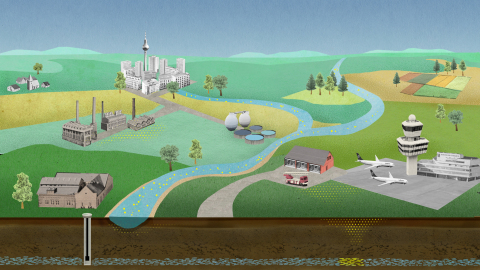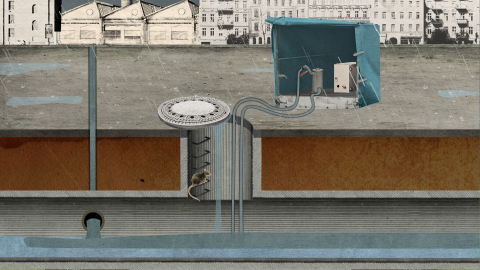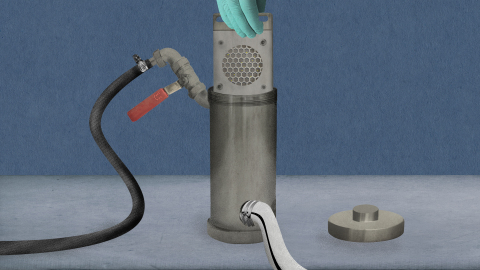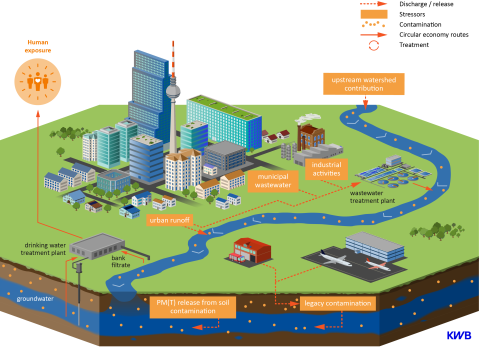CS#1 PFAS and (i)PM(T) fate and remediation in the semi-closed urban water cycle, Berlin
Our aim: Ensure a secure supply of drinking water in the semi-closed water cycle
In Berlin's semi-closed urban water cycle, most drinking water is obtained via bank filtration, which is a proven nature-based solution. But as in most urban areas, the quality of drinking water sources in Berlin is challenged by PFAS and other industrial chemicals.
Case study 1 addressed knowledge gaps on occurrence, fate and treatment of PFAS in several ways: along the urban water cycle, monitoring in industrial wastewater and urban runoff was exemplarily conducted in a selected sub-area of Berlin to identify influencing factors that can cause contamination and are potential sources of industrial chemicals. Based on the results of the monitoring, an emission modeling approach was used to improve the overall management of the urban water cycle by estimating contaminant loads to surface waters. In the field of drinking water treatment, the case study focuses on developing technical measures for the removal of PFAS and other industrial compounds from source water with a high content of organic matter.
Conclusion
To detect PFAS at an even lower limit, we developed a solid-phase extraction (SPE) method that further reduces background noise and amplifies analytes in samples of all relevant water matrices. An automatic SPE to handle multiple samples at once was also developed and subsequently used for monitoring of groundwater, urban runoff, surface- and wastewater.
PFAS monitoring and passive sampling of industrial wastewater
In the PROMISCES project, we designed prototypes of small passive samplers and tested them in surface- and wastewater monitoring campaigns. We were especially interested in finding out how we can better monitor potential industrial emissions from indirect discharges into the sewer system and wastewater treatment plants.
Three effluents from small-scale industries were studied in sampling campaigns directly at the industrial sites. These analyses revealed the presence of PFAS in two of three industrial wastewaters investigated. The three different passive samplers used showed similar results. We were able to demonstrate that passive sampling can give a qualitative insight into industrial wastewater composition also in demanding matrices and can therefore complement conventional sampling. Load-based calibration of passive samplers helps to handle fluctuating concentrations.
Read more of our passive sampling results here.
PFAS monitoring of stormwater runoff
We completed the monitoring of stormwater runoff from two different industrial sites where 12 out of the 24 analysed PFAS were detected at elevated levels. This indicates that stormwater may cause surface waters to exceed the PFAS concentration threshold. To evaluate the impact of stormwater runoff discharge to a smaller urban lake, samples were also taken from lake Flughafensee in Berlin near a legacy contamination site. The measured PFOA-equivalent concentrations (PFAS-24) in stormwater runoff reached the proposed thresholds for surface waters, but concentrations were lower than in wastewater treatment plant effluent, lake Flughafensee and nearby groundwater. Monitoring results of urban stormwater runoff are described here.
Stormwater monitoring data were used to estimate potential emission loads of PFAS and PMT substances into surface water bodies via stormwater runoff, treated wastewater and combined sewer overflows using a specially developed emission model. This model is part of the PROMISCES toolbox for fate and transport modelling.
Performance of drinking water treatment trains for removal of PFAS
To enhance the understanding of competitive adsorption and ion exchange of PFAS and other PMT in the presence of dissolved organic matter, and to optimize their removal from ground- and drinking water in fixed-bed filters, laboratory and pilot-scale experiments were combined with monitoring of a large-scale groundwater treatment plant using with activated carbon at a legacy contaminated site.
Different high performance and tailored adsorbents were tested at laboratory scale and benchmarked against state-of-the-art granular activated carbon. Initially, a comprehensive adsorbent screening was conducted using 18 different adsorbents and spiked drinking water. Based on these results, seven selected adsorbents were chosen for testing in laboratory rapid small-scale column tests with spiked drinking water. In the subsequent piloting, an ion exchange resin and an alternative adsorbent, which had excelled in the laboratory tests, were piloted alongside a large-scale activated carbon plant. Additionally, the most promising treatment train, consisting of a combination of activated carbon and ion exchange, was tested. All process variants were tested at the same site for their ability to remove PFAS from legacy contaminated groundwater. The target analysis in the pilot tests was supplemented by additional sampling campaigns for bioassay testing and for suspect screening. The report on this work can be found here.
Image source: Berliner Wasserbetriebe






.png)